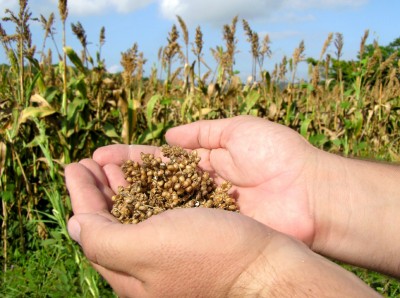Over the past century, America’s population has shifted and expanded to the West, including the desert Southwest and California’s central valley. The new settlers in these areas, used to the plentiful rainfall and moderate summers of the Midwest and Northeast, soon came to realize that gardening in the dry searing heat of their new home presented new challenges. This article provides some tips on having a thriving garden in hot areas of the country.
We need to define what we mean by searing heat. In California’s central valley and the desert Southwest, searing heat means many summer days over 100°F, with days over 110°F common. Winters are defined by low temperatures of 25°F to 30°F.
To have a successful garden, two basic concepts are important: one, take advantage of the entire year; and two, implement the right practices to maximize success during the scorching summers.
Entire Growing Year
If you’re a serious gardener, then you will take advantage of three growing periods. The first is fall/winter, the second is spring, and the third is summer.
Fall/winter gardening is a must if your goal is sustainable gardening on your homestead. Carrots, potatoes, overwintering onions, the cole crops (broccoli, cauliflower, cabbage, and Brussels sprouts), fava beans, and peas can be grown in the mild winter climate.
The second growing period is spring. During this period, you grow crops that are grown during the summer in other areas: tomatoes, peppers, squash, common beans, melons, cucumber, eggplant, corn, and cucumbers. Vegetables that can be started in flats (like tomatoes and peppers) are started indoors in January or February. These seedlings, and the seeds of plants that don’t transplant well (like corn), are planted outside while temperatures are still relatively cool, before the last frost date. Mulch and covering are used to protect the plants during the last frosts of the year. The goal is to get the crops to mature before the searing heat comes. These crops simply won’t survive when it is 110°F outside for days on end. Therefore, it is a balancing act: get the crops in early, but not so early that they die from the cold, and not too late so that the plants die off (or shut down) when it gets too hot out.
The last growing period is during the searing heat of summer. To be successful, you need to keep the soil relatively cool, protect the plants from the sun, water sufficiently, and choose the right vegetable types.
Soil
Soil in these hot climates, without protection or water, can get over 130°F, which will cook the roots of most plants. Therefore, you want to keep the soil as cool as possible. First, use mulch. Second, grow crops in blocks instead of long rows. With rows, there are unplanted sections that collect heat. Finally, you may want to avoid raised beds or hills. Elevated earth is hotter and drier than soil in the ground.
The Secrets Of Sea Minerals To Grow More “Nutritionally-Dense Food” Than You Can Possibly Eat!
Protection from the Sun
Shade cloth is a wonderful material. It allows enough sunlight to provide the necessary exposure to light, but keeps the plants cooler and prevents burning. How much shade cloth to use is up to you. For large-scale gardens, shading the entire area may not be feasible. But for smaller plants in blocks, it’s easy to construct shading for several plants.
Water
Water does many things besides nourish plants. It also keeps the soil cooler. Also, one thing often overlooked is the cooling effect it has on plants. Although most gardening books will tell you to water in the morning due to the danger of disease spreading on wet leaves later in the day, this doesn’t apply in dry, scorching heat. Overhead watering in the afternoon dries soon enough so that disease spreading shouldn’t be an issue, and the water on the plant leaves cools the plants during the hottest part of the day.
The Right Plant Varietals
Before shade cloth, access to offsite water, and the coming of the Europeans, the Native Americans in the West successfully grew crops in the searing heat. In large part, this was due to centuries of experience with the climate, and the knowledge of which plant types (varietals) would grow successfully in the region. You should take the same approach—only grow varietals with a proven track record in dry heat. Below are some examples.
Moth Beans – these small dry beans do well in dry climates with temperatures in excess of 110°F. I grow them every year in California’s central valley. They are more work than other beans, because it takes some labor to extract the small beans from their shells, but they will grow in temperatures where other beans wither and stop producing.
Tepary Beans – these tasty, prolific beans have been grown in the Southwest deserts for over a millennium. There are two cautions about tepary beans, though. First, they can carry the bean common mosaic virus, which is harmful to bean species originating in the Americas. I suggest learning more here before growing tepary beans. The second caution is that many varietals of tepary beans have been adapted to cooler climates, so make sure to choose one that has historically been grown in the Southwest.
Cowpeas – originating from Africa, some varietals do well in the full sun of the West. Avoid varietals adapted to the humid Southeast.
Okra – although okra is often associated with the humid Southeast, it probably originated in the dry, hot climates of Africa or western Asia. In any case, there are varietals that thrive in the searing heat of the West.
Sorghum – although this alternate to corn was historically grown for fodder, today there are varietals intended for human consumption. Sorghum tolerates more heat and more drought than corn. Make sure and choose a varietal intended for consumption, rather than those grown for forage or sugar.
Conclusion
Native Americans successfully grew sustainable crops in the scorching hot areas of our country. With a little hard work and planning, you can too.
 Off The Grid News Better Ideas For Off The Grid Living
Off The Grid News Better Ideas For Off The Grid Living





